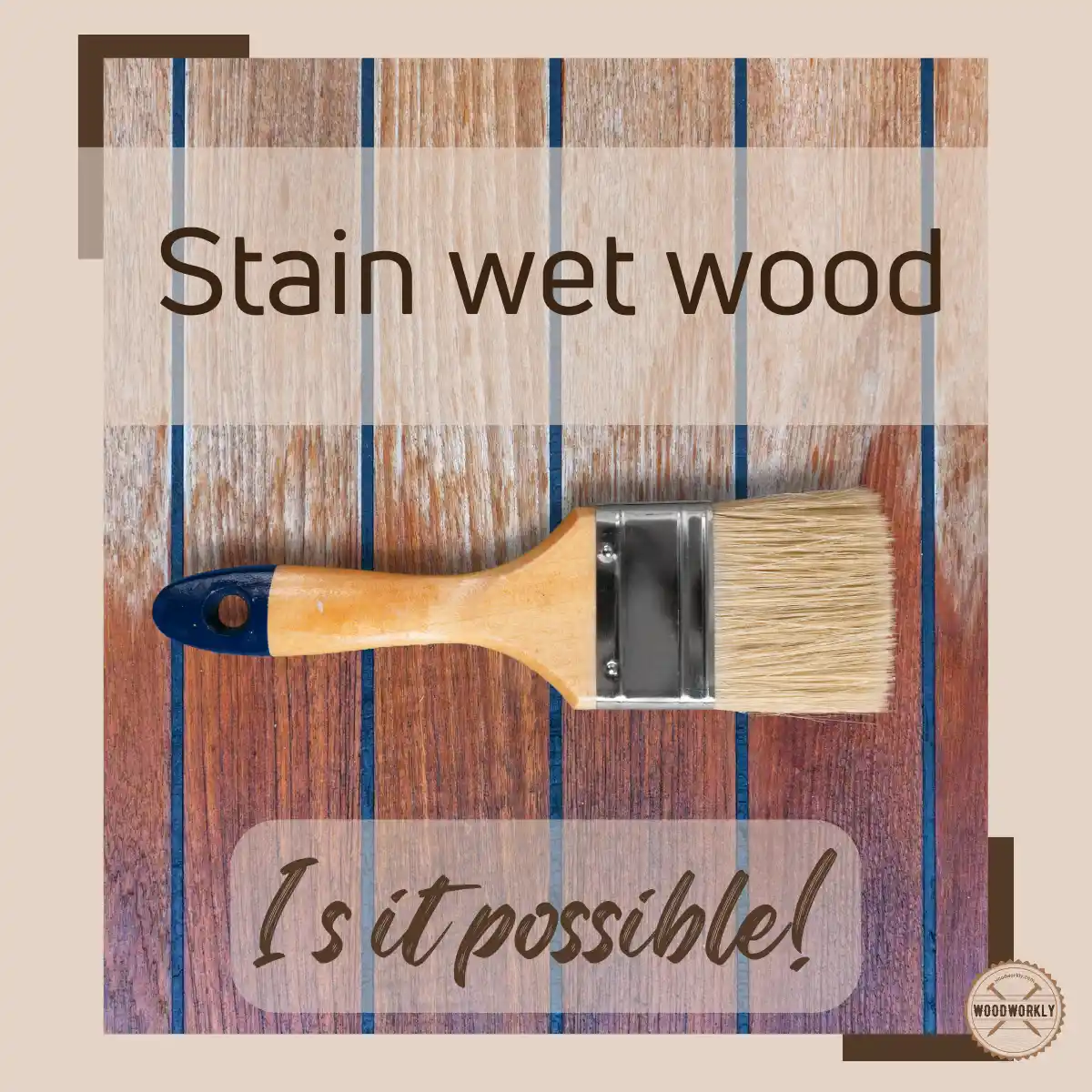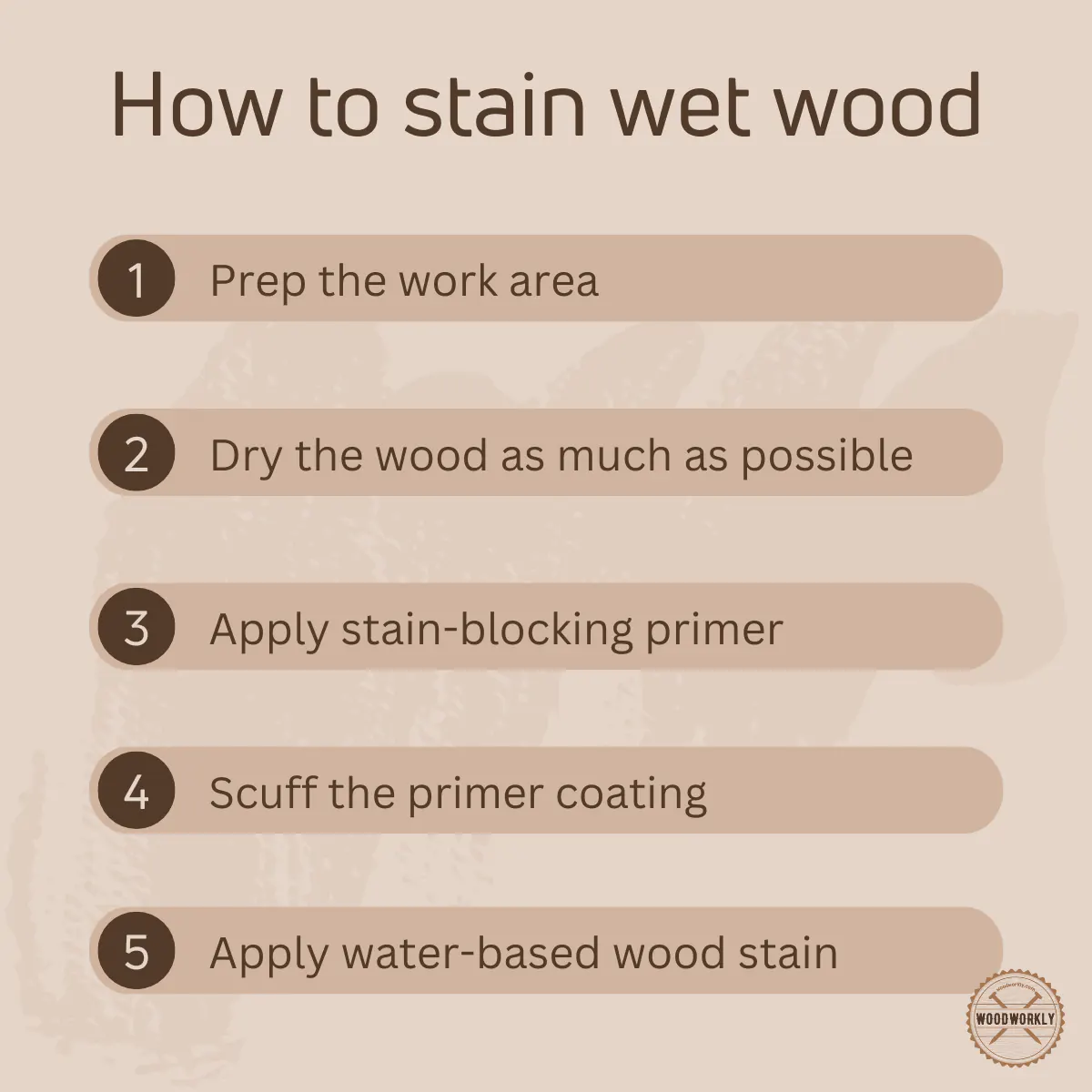Ever wondered if wet wood can embrace a fresh coat of stain? Let’s unravel this woodworker’s dilemma!

Last year in December we had a huge rain in Pennsylvania. Unfortunately, one of our newly made chairs which was in the garden got wet due to the cold weather.
However, this scenario gave me an opportunity to think about staining wet woods. Then I did some research on it with the help of my fellow woodworking experts.
Here’s what I know about, Can you stain wet wood?’
Yes, You can stain wet wood, but the results may not be as perfect as it is with dry wood. Since wet wood contains lots of moisture, wood pores are not available to absorb and penetrate stains into the wood surface resulting in uneven finishing.
But there’s a lot more to know.

In this article, I’ll discuss almost all the ins and outs regarding wet wood staining. Plus, I’ll give some tips that you will need when staining wood.
So, let’s jump in!

Wet Wood
Wet wood also known as damp wood contains a significant amount of water or moisture, tannin, and oil.
A wood with more than 15% moisture is considered wet wood and it can be either freshly cut wood or wood with continuous exposure to rain or humidity.
Water in the freshly cut wood is in two forms; free water in pores and vessels and water trapped in cell walls.
How Does Stain Work on Wood?
Here, the hygroscopic nature of the wood is taken into account. It means the wood consists of a large number of cells and lots of pores that can absorb or lose water.
Not only that, as a result of absorbing and losing water wood can swell and shrink respectively.
But if the wood gets dry, it loses the water in cells and pores by making any liquid that can absorb the wood.
If the stain or paint is applied on the dried wood surface, it can easily penetrate wood fibers, pores, and capillaries.
The capillary action of the wood fibers attracts and wicks the stain to their structures.
When talking about wood stains, consist of a major solvent, which can be most of the time water or oil, and color pigments or dyes and other additives.
If the stain contains pigments, they go and fill the pores and stay on the surface to produce color while if the stain contains a dye, it dissolves with the solvent or carrier liquid for deep penetration of the stain.
During the drying process, the solvent or the carrier liquid evaporates by leaving the pigment and dye on the surface.

Can Wet Wood Be Stained?
In the case of wet woods, there are no adequate pores to absorb enough of the stain. Since the wood is already soaked with water the stain will not adhere adequately.
As a result, the color may not penetrate deeply, resulting in an uneven and weak finish.
This problem is more severe if you are going to use oil-based stains as the solvent, oil doesn’t mix with water.
Although water-based stains can bear it to some extent it’s not a successful solution.
They trap interior excess moisture and seal the outer layer. With time, this results in mold and mildew infection and internal rotting.
However, recent woodworking technology has been advanced to produce commercial products that can be directly applied on wet wood surfaces.
Read to know, Can You Paint Wet Wood (Tips and Best Practices)

Why Staining Wet Wood is Problematic?
These are the reasons I found that making damp wood staining is challenging.
Difficulty in Preparing Surface
Before staining any wood, the surface needs to be cleaned to remove any dirt, mud, and disturbances and the wood needs to be sanded to enhance the adherence of stain.
In the case of damp wood cleaning and sanding can’t be properly done. Due to the high moisture and oil content, the rag will get wet and sandpapers will clog.
Poor Absorption
This is the main problem of wet wood staining. Stains have been designed as they can penetrate the wood pores.
The pores in the wet wood are already filled with moisture, which hinders the stain particles from entering.
This leads to poor absorption and the solvent particle can’t effectively evaporate by sticking dye particles to the wood surface, as with dry wood.
Longer Drying Time
To finish the staining, the solvent needs to be evaporated completely.
Due to the huge water content, all excess water needs to be evaporated before setting the stain.
Hence, it takes a long drying time creating different problems like dripping, smudging, etc.
Reduced Adhesion
As a result of high moisture, stain adhesion is reduced. This reduces the durability of wood and easily can get peeled off.
Staining and Bleeding
The freshly cut wood is full of tannins, oils, and moisture.
Sealing the surface using stain on the surfaces results in building internal pressure and bleeding.
This indicates the turning stain finish into a yellowish color.
Blotchy and Uneven Appearance
The distribution of uneven stains on the wet wood surface due to high moisture content gives a blotchy appearance.
Some areas may absorb more stains than others and some may not. This affects even the finishing and consistency of the process.
Stickiness
If the stain doesn’t dry properly it results in stickiness and bad smell.

Can You Stain Wood After Rain?
Yes, you can stain wood after rain. But it may have some problems eventually. Since wood surfaces like a sponge, it can absorb rainwater.
Unprotected wood exposing continuous rain will produce adverse effects on wood.
Below changes can be expected if the wood is subjected to rain.
Swelling
Wood absorbs moisture and this causes warping, and bowing, and eventually loses the structural integrity and changes the appearance of the wood.
Mold and Mildew Effect
Wet woods are attracted to moist wood surfaces.
If you don’t consider this it will be difficult to remove them from the surfaces and may be harmful to health as well.
Discoloration
Persistent moisture can cause discoloration of the wood. This can affect the appearance of the wood
Decay and Rot
Prolonged exposure to moisture creates an ideal environment for fungi, mold, and wood-decaying organisms to thrive.
These microorganisms can cause wood to rot by leading to a loss of structural integrity and wood degradation.
The stain will not adhere to the wood surface due to loss of penetration and absorption resulting in an uneven and undesirable finish.
So, just applying stain directly on wood will waste your time and cost.
According to the general rule of thumb, it is better to apply stain after drying of wood.
It will take approximately 24-48 hours. The time required to dry depends on the type of wood and the time exposed to rain.

Factors You Need To Consider Before Staining Wet Wood
Although wet wood staining isn’t recommended, there are some occasions that you need to work with wet wood such as green wood, wet-treated wood, and staining after light rain, etc.
Before applying stains on wet wood make sure to consider the following factors before starting the process.
Wood Species
Different wood species have different porosity and moisture absorption capacities.
Woods like cedar, are naturally more resistant to moisture, while woods like pine readily absorb moisture.
Type of Stain
It is important to select a specially designed stain for damp wood rather than a regular wood stain.
Water-based stains are more suitable than oil-based wood stains.
Moisture Content
You can measure the moisture content by using a moisture meter. If the moisture content is less than 15% it is suitable for staining.
Coating
Normally wet woods don’t absorb the stain as they do with dry wood, You’ll necessarily need additional coats.
Application Method
Brushing or rolling damp wood may be more forgiving than spraying, as spraying might result in uneven coverage.
What Are the Best Stains for Wet Wood?
Both water-based and oil-based stains are used by woodworking experts.
Normally water-based trains are better than oil-based stains for wet woods. As I explained so far, damp wood contains lots of moisture, and water and oil don’t mix well to stick stains to the surface.
Now there are water-resistant wood stains in the market. You can choose one and apply.
However, you won’t gain the desired finish and the stain won’t last as long as you expect with dry wood.
How Long Should Wet Wood Dry Before Staining?
The drying time varies depending on factors like wood type, size, moisture content, and environmental conditions.
Also, it varies depending on the drying method: air drying, Klin drying, or pressure treatment. As well as it varies whether it is a green wood or a previously dried wood.
Untreated green woods: For green wood per inch it takes approximately one year for air drying. For 3/4-inch boards, it is nine months, and for 2-inch thick boards, it is 2 years.
Pressure-treated green wood: For this type, it requires 30-90 days of drying time before staining.
Woods subjected to rain or chemically cleaned: For wet woods with previously dried, you need to wait for nearly two days before staining.
How Do You Know The Wood Is Dried Enough To Stain?
I use several techniques to check whether the wood is dried enough before applying stain for a long time.
Try the below techniques to check whether your wood is dried enough to stain.
Check the Hardness
Wet woods are soft and moist when they become dried it turns hard.
Check the Smell
You can identify wet wood by its musty odor. In contrast, dried wood doesn’t smell.
Sandpaper Test
You can sand small areas to check the dryness.
If you can sand the surface properly without wetting or getting stuck you can start the staining process.
Nature of the Wood Surface
Because of board shrinkage, already dried wood shows raised fiber and tiny splinters while wet wood has a smooth surface.
Use Moisture Meter
Moisture meter provides an accurate reading moisture content of wood allowing it to assess its readiness for staining.
There are two common types of meters that you can choose according to your preference.
Pin-Type Meters: These meters have two pins that you can insert into the wood and measure the electrical resistance between the pins, which correlates to the moisture content of the wood.
Pinless Meters: This type can be used when you want to avoid leaving holes in the wood. Here, electromagnetic waves are used to measure the moisture content without penetrating the surface.
The moisture levels should be lower than 15% to take wood as dried.

How To Stain Damp Wood
Staining damp wood isn’t ideal.
According to the general rule of thumb, wood should be stained after drying for best results. However, you will need to stain damp wood in certain circumstances.
Here’s the best process of wet wood staining,
- Gather all the tools and materials.
- Prepare your workplace.
- Allow partial drying of wood.
- Apply a stain-blocking primer.
- Scuff the primer coating.
- Apply water-based stains.
- Let the stain dry and cure
Let’s discuss the process of wet wood staining step by step in detail.
1. Gather All the Tools and Materials
First, you need to collect the following materials and tools.
- A pair of gloves
- Safety goggles
- Drop cloths
- Waterproof sandpapers (220-grit)
- Stir stick
- A paintbrush
- A hairdryer
- Water-based wood stain
- Stain-blocking primer
Check out the Best Brushes For Staining Wood!
2. Prepare your Workplace
You need to arrange your work outside if possible.
Protect your surroundings from being affected and use a drop cloth to collect debris falling off during the process.
3. Allow Partial Drying of Wood
You need to dry the wood surface as much as possible.
For this, do your project in an outdoor, sunny area and use a hair dryer to speed up the drying process.
4. Apply a Stain-Blocking Primer
After a little drying, use a paintbrush to apply stain-blocking primer (e.g. shellac primer) over the surface.
It takes approximately 20 minutes to dry the primer and you need to apply 2-3 coats.
Stain-blocking primers are designed to prevent moisture from seeping out.
5. Scuff the Primer Coating
After drying the primer, use sand papers to lightly sand the primer to promote maximum adhesion.
After sanding remove all the dusts which can create bumps in the final finish.
6. Apply Water-Based Stain
Use a paintbrush or a sprayer to apply a water-based stain along the direction of the wood grain.
Make sure to apply a thin even coat of stain to avoid occurring wood stain mistakes including blotches and streaks.
7. Let the Stain Dry and Cure
After applying the stain evenly all over the wood, let it dry for about 24 to 48 hours. You can accelerate the drying process by using a hair dryer.
After the first coat has dried, you can apply a second coat and allow it to completely dry.
Finally, let the stain coats cure for 2-3 days before use. The stain coat will come to its optimal state upon curing.
Now your wood is ready to use!

Tips for Applying Stain on Damp Wood
Here are the tips that I’ve learned by staining several damp woodworking projects which make the job a lot easier.
- When staining wet wood, preparation is essential for a nice finish. So, take your time with this.
- Use a spray gun instead of a paintbrush. Damp woods may prevent the smooth sliding of a paintbrush.
- Avoid applying thick coats of stain. Apply thin multiple coats for a better, even finish.
- Test a tiny, inconspicuous section of the surface with stain before applying it to the full surface to observe how it responds to the wet wood.
Congrats folks! Now you have a crystal clear knowledge about can you stain wet wood and how to do that properly without forming blotches.
So, let’s answer some frequently naked questions.
FAQs
Why doesn’t wood stain stick to wet wood?
Wood stain struggles to adhere to wet wood due to the presence of moisture, oils, and tannins which fill the wood’s pores, preventing the stain from penetrating properly.
What are the consequences of staining wet wood?
Staining wet wood can lead to a harder prepping process, poor adhesion, discoloration, increased dry time, and a tacky or sticky finish.
How long should wood dry before staining?
Typically, wood should dry for at least 24 hours before staining; however, larger surfaces like decks may require up to 3 days of drying time, depending on the type of wood and environmental conditions.
What type of stain works best on wet surfaces?
For damp or wet surfaces, using water-based stains is recommended as they are more compatible with moisture compared to oil-based stains.
How can you stain wet wood effectively?
To stain wet wood, you should prep the area, dry the wood as much as possible, apply a stain-blocking primer, scuff the primer coating, and then apply a water-based wood stain.
How long should you wait to stain wood after rainfall?
After rainfall, it’s advisable to wait at least 3 days before staining wood, although if the wood has a moisture-resistant layer, a 24-hour wait time might suffice.
What tools are needed to stain wet wood?
Tools you’ll need include a hairdryer, fine-grit and waterproof sandpaper, stain-blocking primer, water-based stain, a paintbrush or spray gun, drop sheets, and a pair of gloves.
How can you speed up the drying process of wet wood before staining?
You can expedite the drying process by using a hairdryer to increase the ambient temperature around the wood or by placing the wood in an area with sufficient sunlight and dry air.
Did I cover all you wanted to know about Can you Stain Wet Wood?
In this article, I’ve deeply discussed whether can you stain wet wood and how to stain wet wood properly using the right techniques with expert tips and tricks!
Staining wet wood is not recommended as it can lead to poor adhesion, uneven coloration, and a tacky finish. It’s best to let the wood dry for at least 24 hours to 3 days before staining for optimal results.
Furthermore, I’ve answered some frequently asked questions as well.
Hope you learned almost all the things regarding applying stains on wet wood. Give them a try!